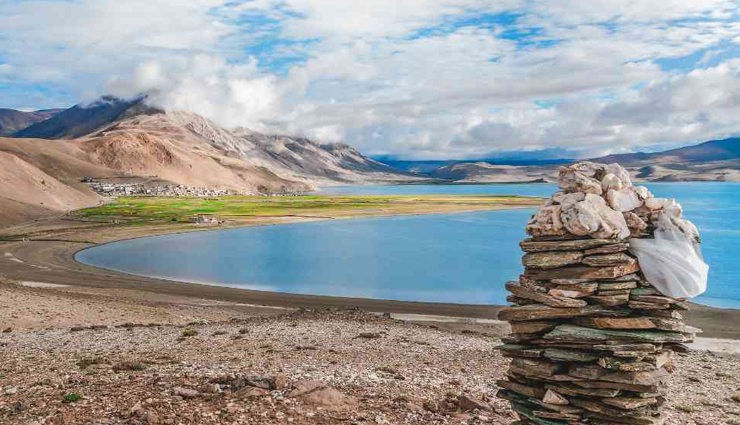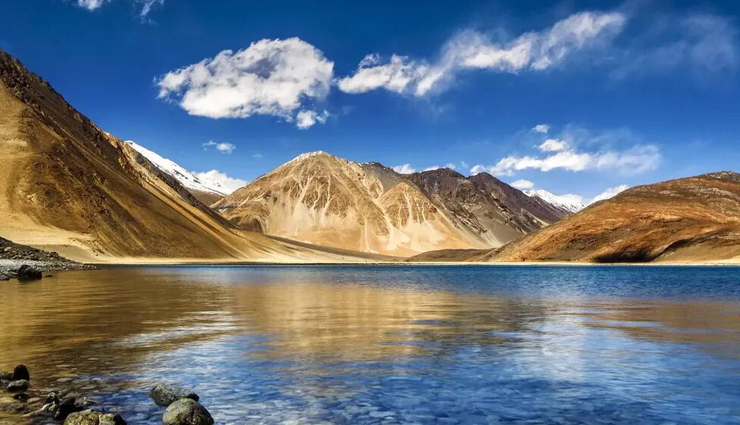
Yes, Ladakh isn't all about dust and daring trails—it also offers peaceful moments beside crystal-clear, gurgling waters.
What’s not to love about these lakes? Their azure surfaces contrast sharply against the parched, rocky backdrop of the Himalayas. As smooth as silk and bursting with life, these waters are home to a diverse range of fauna along their shores—migratory birds and unique wildlife that thrive in Ladakh’s high-altitude ecosystem.

Known locally as the “high grassland lake,” Pangong Lake stuns visitors with its ever-changing hues, shifting shades of blue with the movement of the sun. Stretching across the India-China border, with a portion in India, this saltwater lake offers breathtaking views of the stark landscape and serene skies. Pangong shot to fame after the 2009 Aamir Khan blockbuster 3 Idiots, turning it into a must-visit for fans who still click photos by the iconic movie props placed on its shores. Today, it stands as one of Ladakh’s most Instagram-worthy destinations.
# Tso Moriri
Tso Moriri is the largest alpine lake located entirely within Indian territory. A tranquil retreat, it’s where yellow-beaked ducks glide through crystal-clear waters, and massive mountains are mirrored on the lake's surface. The peaceful surroundings are perfect for those seeking a nature-filled escape. Its shores are home to the Karzok village, one of the highest inhabited settlements in the world. While here, don’t miss the 400-year-old Karzok Monastery or the vibrant Karzok Gustor Festival in July, where Changpa nomads bring a burst of color and culture.
# Tso Kar
Located on the remote Rupshu plateau, Tso Kar—meaning ‘White Lake’ in Ladakhi—is surrounded by majestic mountains that reflect beautifully in its waters. The name comes from the thick salt deposits that line its shores. Though less crowded than Pangong, Tso Kar’s raw beauty and solitude are captivating. It forms a rich wetland ecosystem along with its twin freshwater lake, Startsapuk Tso. Historically, Tso Kar was a key salt source for people in Ladakh and Tibet. Despite its salinity, the lake supports a range of birdlife, including the rare black-necked crane.
Often mistaken for Tso Kar due to its proximity, Startsapuk Tso is a smaller freshwater lake nearby. The two lakes are connected by a stream and can easily be explored together. Though not as vast, Startsapuk offers quiet, scenic views and is ideal for a peaceful stopover if you have the time.
# Kyagar Tso
Located en route to Tso Moriri, Kyagar Tso is a small yet stunning lake with turquoise waters and a fair share of local wildlife. Its beauty is reminiscent of a painted canvas, but with a surreal shimmer. During winter, the lake freezes into a magical, frosty landscape. With no nearby shelters or fuel stations, the isolation here adds to the experience—offering true solitude and a chance to connect with yourself.
# Mirpal Tso
Hidden below the Kaksang La Pass in the Changthang region, Mirpal Tso is a hidden emerald gem cradled by brown-black mountains. The vibrant water set against muted surroundings creates a breathtaking view. Though less popular, this lake offers untouched serenity, perfect for soul-searching and quiet reflection. It’s also a haven for bird watchers, with migratory birds frequenting its shores. A night of camping here can be followed by a visit to the nearby Yaye Tso.